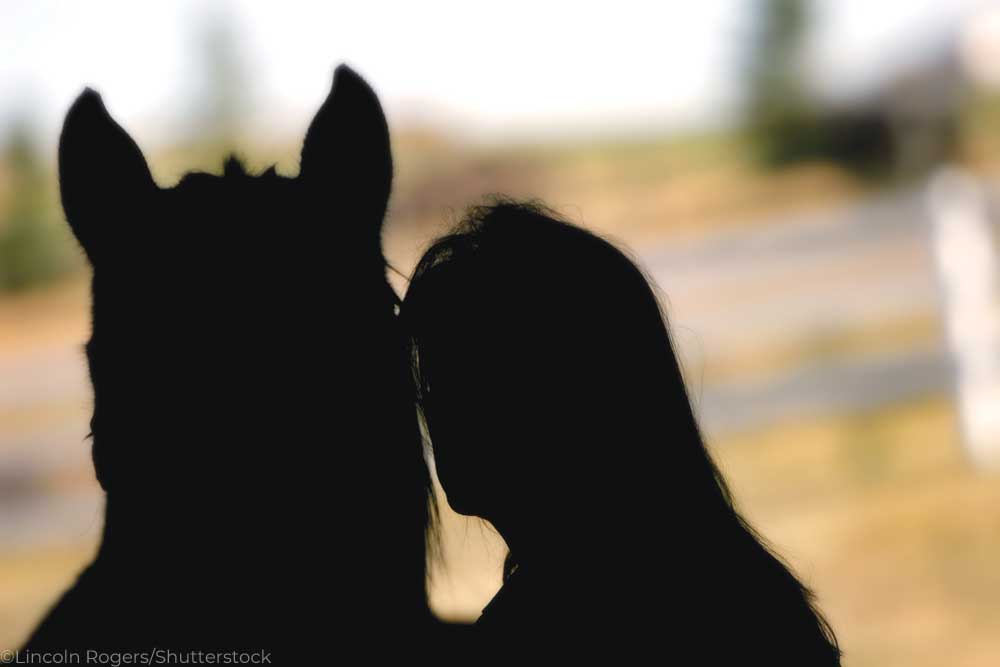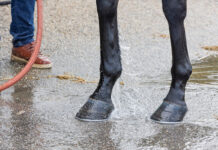- An increasing number of horse owners are choosing to keep horses that they don’t ride.
- Owners of companion horses have created organizations to promote and encourage keeping of non-ridden horses.
- Some owners practice liberty and other forms of groundwork with their horses. Many find benefits in working with their horses in this way.
When busy attorney Sigrid Haines set out to adopt a horse, she knew exactly what kind she wanted. “I’ve been riding on and off most of my life, but in my most recent lessons, I found myself wanting to spend more time with the horse and less time on the riding,” says Haines. “I have a stressful job and I just wanted to play, so I kept wanting to get off to interact with the horse in a different way. I deliberately set out to adopt an unrideable horse.”

In fact, over the years she adopted five of them: a pair of retired therapy horses, Harpo and May, plus Nicky, Santana and Mocha, adopted through Days End Farm Horse Rescue (DEFHR) in Maryland.
“I have way more fun now than I did when I was riding,” says Haines.
Raising Awareness
Haines is among a growing number of horsekeepers who are acquiring horses that they never intend to ride, says Caroline Robertson, DEFHR’s director of development. According to Robertson, in 2018, 34 out of the organization’s 78 adoptions involved “companion” horses. That’s up from 17 out of 53 adoptions in 2017. Age and medical conditions rendered some of those horses unrideable, but Robertson also credits a new awareness with the interest in these horses.

“The uptick we are now seeing is due to an intentional marketing effort spotlighting these companion horses, making them more a part of the industry conversation around adoption as the preferred option,” Robertson explains. “The result is that the companion horses in our programs are finding a home sooner, so we’re now able to place more into homes each year.”
Meanwhile, non-ridden horses have been getting a boost on social media as well. In 2017, the UK-based Vicky Jayne Yates and her husband, Steven, established the The Non Ridden Equine group on Facebook to help owners of these horses connect, share stories, swap photos and exchange horsekeeping tips.
Within months, the group grew to more than 10,000 members and spawned affiliates in the U.S., including The Non Ridden Equine New England. All the groups are focused on promoting the value of horses that either cannot be ridden or that their owners will never ride for one reason or another.
“It doesn’t mean that people who have non-ridden horse can’t ride or never ride, but riding is not a priority for them,” says Gabriela Rodriguez Quinn, director of BlixxHorses, a non-profit that advocates for horses and their care, and founder of The Non Ridden Equine New England. “Caring for the horse is number one, and riding is number two.”
Quinn became a non-ridden horse owner after she purchased Blue, an off-track Thoroughbred. After riding him in various disciplines, she acquired Lexxie, an Arabian filly that has never been under saddle.
“I learned to pony Lexxie when I was riding Blue, and I’d take both horses for walks on the beach,” says Quinn.
Increasingly she realized that caring for her horses was more important to her than riding them.
According to Quinn, while members of The Non Ridden Equine New England range in age from their 30s to well beyond, they all share an interest in learning about their horses and how to care for them.
“More people are committed and educated regarding the horse’s needs and costs, and they are willing to make the commitment required to keep a horse in good care for life regardless of riding or driving status,” says Quinn.
Benefits of Non-Ridden Horses
Owners of non-ridden horses derive other benefits, too, according to Christine Massinger, a former lawyer and judge from Pennsylvania who now works as a licensed Parelli professional trainer in Florida. While many of her clients are equestrians, both mounted and non-mounted students all begin their training with ground work: working with the horse on a long line in a round pen or at liberty, where the horses respond to human cues and body language. The exercises are intended to help their human handlers develop a bond with the horses.

“Liberty allows people to bond with horses in a safe way, and it’s one of the ways the non-ridden horses bond with their owners,” says Massinger. “In fact, you can develop a deep spiritual connection [with the horse] that you can’t get in the saddle.”
People who engage in groundwork with their horses probably get more exercise than their mounted counterparts, says Massinger, and working with non-ridden horses also benefits people who have physical limitations of their own.
“While [adopting and working with] non-ridden horses gives more options to horses that can’t be ridden because of their physical limitations, it also gives more options to people with arthritis or other conditions by allowing them to still be able to enjoy horses,” she says.
As a result, non-ridden horses have often been at the core of programs that focus on horses’ ability to solicit emotional energy in equine assisted therapy (EAT) clients. The horses are also finding a niche in programs aimed at corporate team building, says Jen Hall, founder of Zenerjen, a Florida-based firm that offers corporate executives, business owners and individuals the opportunity to enhance their relationships by working with her trio of rescued non-ridden horses.
A Powerful Relationship
“People need to stop looking at horses only as performance animals,” says Hall. She urges equestrians to go to the rescues and look at adopting the horses that have limitations. “Even if you don’t ride, you can still have a powerful relationship with the horse.”

Haines and Quinn are bringing similar messages to their communities. Quinn and her horses frequently walk the beach in her neighborhood, visiting with onlookers curious to touch the horses and learn about their handling and care.
“Some people have never seen a horse on the beach before,” she says. “People see us [taking our walks] and sometimes join us. We want to help people learn about horses.”
She has also brought her horses to visit patients at a local chemotherapy infusion center so they can pet the horses and forget for a while about what they are going through. She also plans to involve her horses in a local EAT program for veterans.
Likewise, Haines loves to share her horses’ attributes.
“We show off our new little tricks to the other boarders, and my friends come out to visit,” says Haines. “In the spring, a senior citizen community is sending a busload of residents out, and we’ll put on a show.”
Ultimately though, Haines believes non-ridden horses have enriched her own life.
“I decided I was done with riding, but I still wanted to be around horses, and I have way more fun now than I did when I was riding,” she says. “It’s a joy to make another creature happy, and I get back more than I put into it.”
This article originally appeared in the May 2019 issue of Horse Illustrated magazine. Click here to subscribe!






Due to age ;I find myself in a non-riding situation. At some point I may have to part with my horse and I would like to connect with caring people such as these.
So happy to read an article like this. It gives me hope that more and more people will realize that the real power of horse is not using them as a means to one’s equestrian goals, but to be a true companion to the horse and let the horse be who they want to be. This will naturally promote a strong bond with the horse. I have 5 Icelandic Horses and I have not ridden in years. The non-use of horses also promotes life long care for the horse until they pass away. All but one of my horses is well over 20 years old. I have 2 that are in their 30’s. Three are unrideable due to arthritis, stroke, and a leg that was broken and repaired in 2002. When I am down to only one horse, I will be looking for a companion horse. Thank you for this lovely article.
I have a handsome, sweet 13 yr.old Tennessee Walker that has been diagnosed with Trigeminal Nerve Disorder. After a year and a half of trying everything I could to keep him rideable, I have had no success, and want to find a home to retire him. He is not in pain when he is not tacked up and being ridden, and I think he could be happy just hanging out. I live in the desert and on a 1 acre lot in a development, it would be cruel to pen him here for the rest of his life , that is why I feel I need to rehome him. Some people tell me to destroy him, but I love him very much and want him to have a chance, since he is only 13. I wonder if I am being unreasonable about this.
Thank you for this wonderful article. There are so many ways you can enjoy being with your horses.
We are older adults and enjoy in-hand work with our horses, fitness work over poles in the arena, and some games. We are learning many things, and it’s also delightful to discover what you horse enjoys. An occasional short ride for 20-25 minutes, a gift from the horse, seems to be acceptable.
But definitely, their preference appears to be fun, in-hand work. When my horse has had enough and wants to leave the arena for a walk and graze, he lets me know. He picks up the crop (only used to swat flies) and drops it — that’s his signal to go out.
The more we can learn about in-hand work and (non forced) liberty work, the better.
Thank you for this inspiring piece.
Nuala Galbari
David L. Justis, M.D.